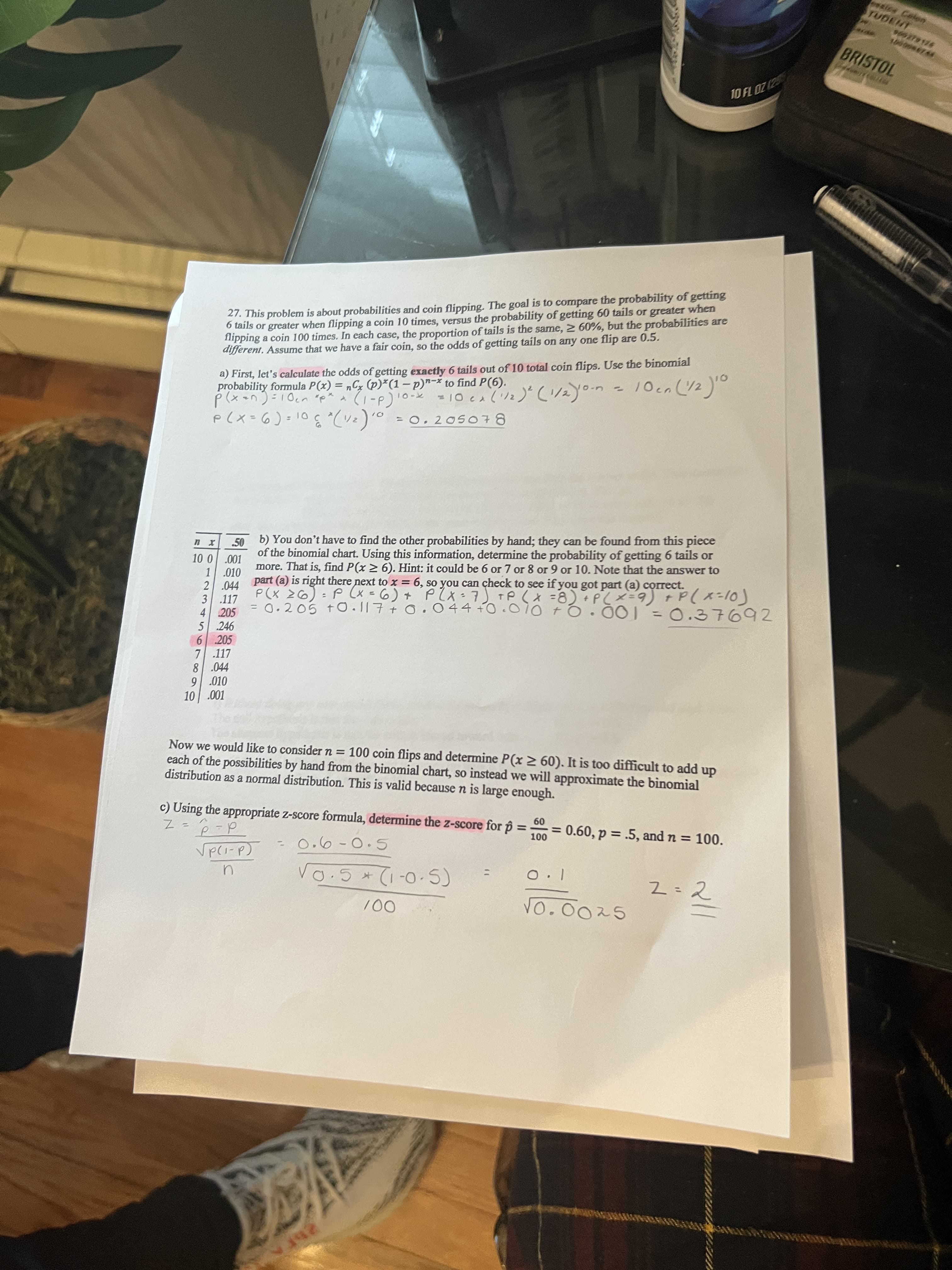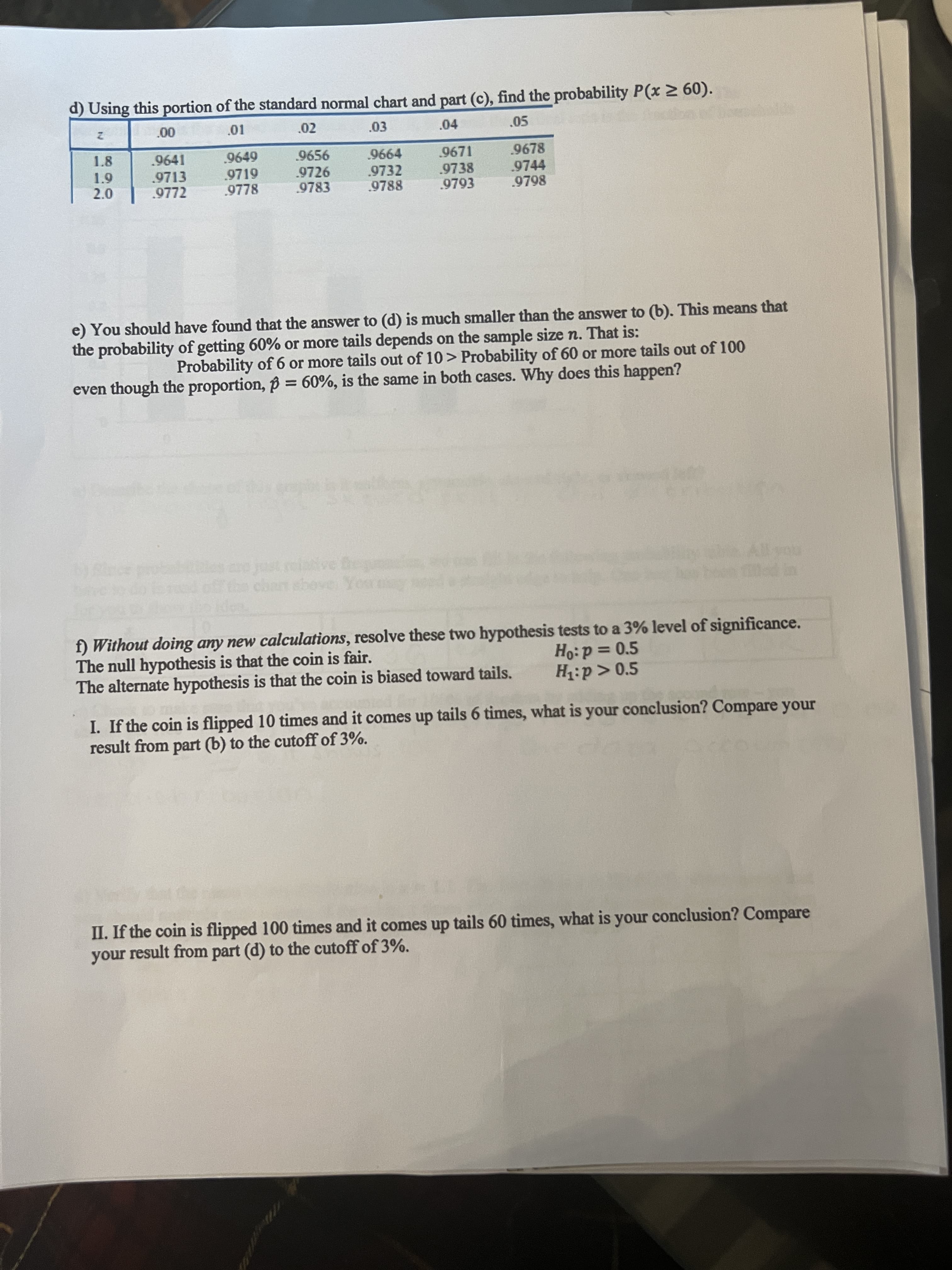BRISTOL 27. This problem is about probabilities and coin flipping. The goal is to compare the probability of getting 6 tails or greater when flipping a coin 10 times, versus the probability of getting 60 tails or greater when flipping a coin 100 times. In each case, the proportion of tails is the same, 2 60%, but the probabilities are different. Assume that we have a fair coin, so the odds of getting tails on any one flip are 0.5. a) First, let's calculate the odds of getting exactly 6 tails out of 10 total coin flips. Use the binomial probability formula P(x) = „Cx (p)*(1– p)"-x to find P(6). (d-1). =0, 2050078 -10 c2)(2yo.n - 10cn (/2 %3D %3D 50 b) You don't have to find the other probabilities by hand; they can be found from this piece of the binomial chart. Using this information, determine the probability of getting 6 tails or more. That is, find P(x > 6). Hint: it could be 6 or 7 or 8 or 9 or 10. Note that the answer to part (a) is right there next to x = 6, so you can check to see if you got part (a) correct. 0” |乙 10 0 .001 %3D %3D 3 .117 L 205 = 0.205 t0.117 + 0.044 +0.010 tO 001 =0.3769 2 %3D 5 .246 6 205 7 .117 9.010 10 .001 Now we would like to consider n= 100 coin flips and determine P(x 2 60). It is too difficult to add up each of the possibilities by hand from the binomial chart, so instead we will approximate the binomial distribution as a normal distribution. This is valid because n is large enough. c) Using the appropriate z-score formula, determine the z-score for p = = 0.60, p = .5, and n = 100. 09 %3D d- d - O.6-0.5 %3D (d-1)d^ 1.0 %3D Vo.0025 d) Using this portion of the standard normal chart and part (c), find the probability P(x 2 60). .01 .02 .03 .04 .05 .9678 .9744 9798 .9649 9656 .9726 9783 9671 9738 9793 1.8 .9641 .9713 9772 .9719 .9778 +996 .9732 2.0 9788 e) You should have found that the answer to (d) is much smaller than the answer to (b). This means that the probability of getting 60% or more tails depends on the sample size n. That is: Probability of 6 or more tails out of 10> Probability of 60 or more tails out of 100 even though the proportion, p = 60%, is the same in both cases. Why does this happen? chan sbeve Yest f) Without doing any new calculations, resolve these two hypothesis tests to a 3% level of significance. The null hypothesis is that the coin is fair. The alternate hypothesis is that the coin is biased toward tails. %3D I. If the coin is flipped 10 times and it comes up tails 6 times, what is your conclusion? Compare your result from part (b) to the cutoff of 3%. II. If the coin is flipped 100 times and it comes up tails 60 times, what is your conclusion? Compare your result from part (d) to the cutoff of 3%.
BRISTOL 27. This problem is about probabilities and coin flipping. The goal is to compare the probability of getting 6 tails or greater when flipping a coin 10 times, versus the probability of getting 60 tails or greater when flipping a coin 100 times. In each case, the proportion of tails is the same, 2 60%, but the probabilities are different. Assume that we have a fair coin, so the odds of getting tails on any one flip are 0.5. a) First, let's calculate the odds of getting exactly 6 tails out of 10 total coin flips. Use the binomial probability formula P(x) = „Cx (p)*(1– p)"-x to find P(6). (d-1). =0, 2050078 -10 c2)(2yo.n - 10cn (/2 %3D %3D 50 b) You don't have to find the other probabilities by hand; they can be found from this piece of the binomial chart. Using this information, determine the probability of getting 6 tails or more. That is, find P(x > 6). Hint: it could be 6 or 7 or 8 or 9 or 10. Note that the answer to part (a) is right there next to x = 6, so you can check to see if you got part (a) correct. 0” |乙 10 0 .001 %3D %3D 3 .117 L 205 = 0.205 t0.117 + 0.044 +0.010 tO 001 =0.3769 2 %3D 5 .246 6 205 7 .117 9.010 10 .001 Now we would like to consider n= 100 coin flips and determine P(x 2 60). It is too difficult to add up each of the possibilities by hand from the binomial chart, so instead we will approximate the binomial distribution as a normal distribution. This is valid because n is large enough. c) Using the appropriate z-score formula, determine the z-score for p = = 0.60, p = .5, and n = 100. 09 %3D d- d - O.6-0.5 %3D (d-1)d^ 1.0 %3D Vo.0025 d) Using this portion of the standard normal chart and part (c), find the probability P(x 2 60). .01 .02 .03 .04 .05 .9678 .9744 9798 .9649 9656 .9726 9783 9671 9738 9793 1.8 .9641 .9713 9772 .9719 .9778 +996 .9732 2.0 9788 e) You should have found that the answer to (d) is much smaller than the answer to (b). This means that the probability of getting 60% or more tails depends on the sample size n. That is: Probability of 6 or more tails out of 10> Probability of 60 or more tails out of 100 even though the proportion, p = 60%, is the same in both cases. Why does this happen? chan sbeve Yest f) Without doing any new calculations, resolve these two hypothesis tests to a 3% level of significance. The null hypothesis is that the coin is fair. The alternate hypothesis is that the coin is biased toward tails. %3D I. If the coin is flipped 10 times and it comes up tails 6 times, what is your conclusion? Compare your result from part (b) to the cutoff of 3%. II. If the coin is flipped 100 times and it comes up tails 60 times, what is your conclusion? Compare your result from part (d) to the cutoff of 3%.
Glencoe Algebra 1, Student Edition, 9780079039897, 0079039898, 2018
18th Edition
ISBN:9780079039897
Author:Carter
Publisher:Carter
Chapter10: Statistics
Section10.4: Distributions Of Data
Problem 19PFA
Related questions
Question
Can you only answer 27 D,E,F ONLY those

Transcribed Image Text:BRISTOL
27. This problem is about probabilities and coin flipping. The goal is to compare the probability of getting
6 tails or greater when flipping a coin 10 times, versus the probability of getting 60 tails or greater when
flipping a coin 100 times. In each case, the proportion of tails is the same, 2 60%, but the probabilities are
different. Assume that we have a fair coin, so the odds of getting tails on any one flip are 0.5.
a) First, let's calculate the odds of getting exactly 6 tails out of 10 total coin flips. Use the binomial
probability formula P(x) = „Cx (p)*(1– p)"-x to find P(6).
(d-1).
=0, 2050078
-10 c2)(2yo.n - 10cn (/2
%3D
%3D
50 b) You don't have to find the other probabilities by hand; they can be found from this piece
of the binomial chart. Using this information, determine the probability of getting 6 tails or
more. That is, find P(x > 6). Hint: it could be 6 or 7 or 8 or 9 or 10. Note that the answer to
part (a) is right there next to x = 6, so you can check to see if you got part (a) correct.
0” |乙
10 0 .001
%3D
%3D
3 .117
L 205 = 0.205 t0.117 + 0.044 +0.010 tO 001
=0.3769 2
%3D
5 .246
6 205
7 .117
9.010
10 .001
Now we would like to consider n= 100 coin flips and determine P(x 2 60). It is too difficult to add up
each of the possibilities by hand from the binomial chart, so instead we will approximate the binomial
distribution as a normal distribution. This is valid because n is large enough.
c) Using the appropriate z-score formula, determine the z-score for p = = 0.60, p = .5, and n = 100.
09
%3D
d- d
- O.6-0.5
%3D
(d-1)d^
1.0
%3D
Vo.0025

Transcribed Image Text:d) Using this portion of the standard normal chart and part (c), find the probability P(x 2 60).
.01
.02
.03
.04
.05
.9678
.9744
9798
.9649
9656
.9726
9783
9671
9738
9793
1.8
.9641
.9713
9772
.9719
.9778
+996
.9732
2.0
9788
e) You should have found that the answer to (d) is much smaller than the answer to (b). This means that
the probability of getting 60% or more tails depends on the sample size n. That is:
Probability of 6 or more tails out of 10> Probability of 60 or more tails out of 100
even though the proportion, p = 60%, is the same in both cases. Why does this happen?
chan sbeve Yest
f) Without doing any new calculations, resolve these two hypothesis tests to a 3% level of significance.
The null hypothesis is that the coin is fair.
The alternate hypothesis is that the coin is biased toward tails.
%3D
I. If the coin is flipped 10 times and it comes up tails 6 times, what is your conclusion? Compare your
result from part (b) to the cutoff of 3%.
II. If the coin is flipped 100 times and it comes up tails 60 times, what is your conclusion? Compare
your result from part (d) to the cutoff of 3%.
Expert Solution
This question has been solved!
Explore an expertly crafted, step-by-step solution for a thorough understanding of key concepts.
Step by step
Solved in 5 steps

Recommended textbooks for you

Glencoe Algebra 1, Student Edition, 9780079039897…
Algebra
ISBN:
9780079039897
Author:
Carter
Publisher:
McGraw Hill

Glencoe Algebra 1, Student Edition, 9780079039897…
Algebra
ISBN:
9780079039897
Author:
Carter
Publisher:
McGraw Hill